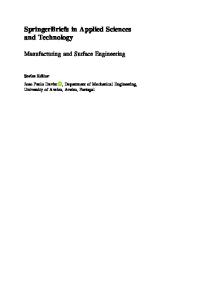Exploring cutting front profile in abrasive water jet machining of aluminum alloys
- PDF / 694,811 Bytes
- 7 Pages / 595.276 x 790.866 pts Page_size
- 46 Downloads / 280 Views
ORIGINAL ARTICLE
Exploring cutting front profile in abrasive water jet machining of aluminum alloys Shu Wang 1 & Dong Hu 1 & Fengling Yang 1 & Chuanlin Tang 1 & Peng Lin 1 Received: 19 July 2020 / Accepted: 9 November 2020 # Springer-Verlag London Ltd., part of Springer Nature 2020
Abstract As the only cold high-energy beam machining technology, abrasive water jet (AWJ) has a very broad application prospect in material manufacturing industry. However, the application of AWJ is limited by the machining accuracy it can be achieved. To get higher accuracy in the AWJ cutting process, a better understanding of the cutting front is necessary since the machining accuracy is decided by the cutting front of AWJ. In this paper, the influence of machining parameters on the cutting front profile has been investigated. Based on the investigation, the cutting front profile model has been built and verified. With this mathematical model, predicting the cutting front profile accurately according to the cutting conditions becomes feasible and practical, which further leads to higher precision cutting of AWJ. Keywords Abrasive water jet . Cutting front profile . Curve fitting . Predictive model
1 Introduction When water is pressurized to high pressure and discharged from a small orifice, a high-speed water jet is formed. The abrasive water jet (AWJ) is formed by adding abrasive particles into the high-speed water jet [1]. All kinds of materials can be cut by using AWJ. As the only cold high-energy beam machining technology, AWJ has many advantages, so it is widely used in the material processing industry. Its advantages include no heat effect, no pollution to the environment, and high efficiency [2]. According to the existing data, it is clear that in many industrial fields, this technology can be used to cut parts with tolerances less than 0.1 mm, but the cutting accuracy cannot be further improved. In the process of AWJ cutting, the jet is deflected opposite to the direction of the motion. That is to say, the exit of the jet from the material lags behind the point at the top of the material where the jet enters [3]. The jet-material interface is called the cutting front (as shown in Fig. 1). Unlike those traditional manufacturing methods, in which the machining accuracy is decided by the shape of tool, AWJ’s * Dong Hu [email protected] 1
School of Energy and Electromechanical Engineering, Hunan University of Humanities, Science and Technology, Loudi, China
machining accuracy is decided by the cutting front of AWJ [4]. Therefore, it is necessary to further explore the behavior of the cutting front [5]. Many research scholars have conducted research on AWJ cutting front and have achieved many research results. Hashish recorded the cutting process of transparent materials using a high-speed camera and then studied the formation mechanism of the jet lag and cutting front [6]. Matsui et al. analyzed the cutting front and found that the arc can be used to represent the contour of cutting front, and the relationship between cutting s
Data Loading...











